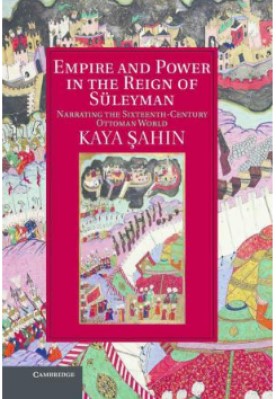Empire and Power in the Reign of Süleyman: Narrating the Sixteenth-Century Ottoman World

| Empire And Power In The Reign Of Suleyman |
| Şahin, Kaya |
| 11567 |
| |
| PDF Direct Link |
| Click for Copy from Amazon |
EMPIRE AND POWER IN THE REIGN OF SULEYMAN – Book Sample
About the Book
Study shows that, in contrast with many Eurocentric views, the Ottomans were active players in European politics, with an imperial culture in direct competition with that of the Habsburgs and the Safavids.
Kaya Şahin’s book offers a revisionist reading of Ottoman history during the reign of Süleyman the Magnificent (1520-1566).
By examining the life and works of a bureaucrat, Celalzade Mustafa, Şahin moves beyond traditional, teleological approaches and argues that the empire was built as part of the Eurasian momentum of empire building, and demonstrates the imperial vision of sixteenth-century Ottomans.
This unique study shows that, in contrast with many Eurocentric views, the Ottomans were active players in European politics, with an imperial culture in direct competition with that of the Habsburgs and the Safavids.
Indeed, this book explains Ottoman empire building with reference to the larger Eurasian context, from Tudor England to Mughal India, contextualizing such issues as state formation, imperial policy, and empire building in the period more generally.
Şahin’s work also devotes significant attention to the often-ignored religious dimension of the Ottoman-Safavid struggle, showing how the rivalry redefined Sunni and Shiite Islam, laying the foundations for today’s religious tensions.
History Writing between Imperial Advocacy and Personal Testimony
History writing preoccupied Ottomans from different social and cultural backgrounds throughout the empire’s lifespan, and the product of their labors reached relatively large audiences.
After the mid-fifteenth century, and particularly in the first half of the sixteenth century, there emerged an Ottoman “historical culture” that encompassed “habits of thought, languages, and media of communication, and patterns of social convention that embrace[d] elite and popular, narrative and non-narrative modes of discourse” about the distant and near-past of the empire.2
History writing often dealt with contemporary issues, sometimes obliquely and sometimes quite openly, and thus constituted a privileged instrument for political commentary.3
This historical culture is visible not only in works of history proper, but also in the increased references to history and historical precedent in law, poetry, administrative documents, and political debates.4
For the first two centuries of the Ottoman enterprise, the scarcity or irregularity of materials such as the land survey registers, court records (sicil), and chancery documents directed scholars to focus on historical works produced in Ottoman and adjacent territories.
Works of history written inside the Ottoman realm by the sultans’ subjects, although first produced a century or more after Osman’s death (r. 1300?–26), have been studied to explain the “foundation” of an Ottoman “Empire.”5 These chronicle-based inquiries, whose apparent objective was to produce a coherent chronology of events and an exhaustive listing of historical actors, were often marred by their authors’ Orientalist or Turkish nation- alist mindsets.
These mindsets have been the subject of a powerful critique from the 1980s onward. Going beyond the positivism of the earlier generations, the critical scholars have emphasized the narrative aspects of these early works and discussed the creation of a quasi-mythological aura around the early days of the Ottoman dynasty.6
Thanks to these debates, fifteenth-century Ottoman historiography has remained, for a long time, a popular field of study, which led to the publication of a considerable number of critical editions, albeit of uneven quality. For instance, Aˆ s¸ıkpas¸azade’s popular Tevarıh-i Al-i Osman saw many editions in the twentieth and twenty-first centuries.
The Anonymous cycle and works by Ruhi, Nes¸ri, Kıvami, and Tursun Bey have been published in critical editions. Even historical miscellany from the fifteenth century immediately attracts attention and is either published or used in analytical studies.
In contrast, sixteenth-century works of history, which range, in terms of the present discussion, from Kemalpas¸azade Ahmed’s Teva¯ rı¯h-i ¯ …..
˘
To read more about the Empire And Power In The Reign Of Suleyman book Click the download button below to get it for free
Report broken link
Support this Website
 Don't Miss out any Book Click Join OpenMaktaba Telegram group
Don't Miss out any Book Click Join OpenMaktaba Telegram group